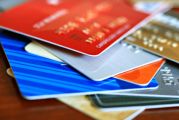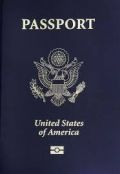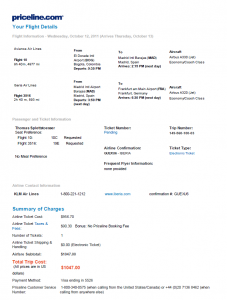Around the World Travel Advice: Your travel wallet and other handy documents
Feb 26, 2014
Watch, wallet, spectacles and testicles… Check, check, check and… well you get the idea. So the time has arrived, you’ve executed your savings plan, you’ve set your gaze on the horizon and you’ve got your bags packed. Now before you head out into the unknown, take a little time to check the contents of your wallet and get a few things in order.
 1. ATM/Debit Cards: ATM fees, foreign transaction fees, and conversion rate differences can have a big impact on your wallet each month, especially when you’re living off your account and using ATMs very regularly. That is of course unless you’re rockin’ the Charles Schwab High-Yield Investor Checking Account linked to a Charles Schwab Brokerage account.
1. ATM/Debit Cards: ATM fees, foreign transaction fees, and conversion rate differences can have a big impact on your wallet each month, especially when you’re living off your account and using ATMs very regularly. That is of course unless you’re rockin’ the Charles Schwab High-Yield Investor Checking Account linked to a Charles Schwab Brokerage account.
I could go into a number of different banks we checked out and what we found through our research but I prefer to cut to the chase, so we’ll skip those and simply say “Chuck’s got your back.” Charles Schwab (Chuck) offers a pair of accounts that are perfect for the Around the World traveler and Career Breaker alike. They are the High-Yield Checking and linked Brokerage accounts which, when opened together have no monthly minimum and some really great perks. The big one is fee reimbursement. ATMs charge for convenience and when you’re on the road, they’re usually your only way to draw cash from your accounts so you’ll use them quite often. With this account, Chuck will reimburse you for every fee from anywhere in the world with no limit on the number of times you use your ATM card. In addition, you won’t be charged any foreign transaction fee. So if you’re in Honduras and your withdrawing Lempiras at the often broken ATM on Utila, whatever you take out in Lempiras will be withdrawn from your US account in exact US dollars promising you fair rates of exchange anywhere in the world. The same goes for purchases made using your check card! This is the best deal going in my opinion. Other things that are free with this account are Checks, Transfers from external accounts, Bill Pay, Debit/ATM card replacement, Overdrafts, Stop Payments, incoming Wires, and GREAT customer service. Oh yeah… you earn great interest on both accounts; well over the standard of almost all other accounts so your money will earn you more money.
Bottom line, get this account and you can thank me later.
2. Credit Cards: I really hate credit cards with a passion. They drive risky spending behaviors, they cost too damn much, and you have to play by their rules, which they reserve the right to change without notice. That being said, they are a necessary evil when traveling and when used properly, can actually save you money.
So I won’t try to tell you which Credit Card is the best for YOU but I will tell you what I think was best for us. Originally, I thought I wanted a no-interest for the first 18 months credit card, which I received from Citibank. Overall, it was a pretty slick card and having no interest was the major draw. As I began using the card though, I found that the points they gave you were pretty worthless unless you really like shitty magazines and I was paying the balance completely every month so who cares about the 0% interest rate? Then it hit me, I should use a card for all my spending (during my savings period and on bigger expenses while on the road) and take advantage of the points to save us some money on airline tickets. To that end, I got the United Mileage Plus card from Chase. Now before you jump on-board with this card consider that it has a yearly membership fee of $95 USD. Yes, that sucks, but the reason I chose that card was that I had a bunch of points already through United (work travel) AND they gave me 50k points for signing up. They also waive the fee for the first year. Now you only get that 50k in points when you spend $1k in the first 3 months and add a joint account holder. But with Jen needing a card and my monthly bills totaling more than $1k, we easily got the points. United also throws in two club passes each year which have a about a $45 value so your $95 fee isn’t a complete waste. Lastly, United is part of the Star Alliance, which means your points can be used on lots of other airlines around the world.
Bottom line on this one, 0% APR is nice but if you’re paying your balance every month anyway then go for the points. Jen and I have about 170k in points, which is enough to cover both of our most expensive flights across the Pacific with plenty left over, which has a combined value of about $2500. This doesn’t make the $95 fee sound so bad.
 3. Cash: It’s king for a reason and if you’re in the US, you’ve got green-backs, which can be pretty handy in a lot of places.
3. Cash: It’s king for a reason and if you’re in the US, you’ve got green-backs, which can be pretty handy in a lot of places.
Bring some cash with you. Hide a bill here or there just for reserves. You never know, you may need to whip out a $20 to pay a fine “on the spot” (a bribe) and save yourself some hassle after you’ve been caught riding a scooter like a mad man in Thailand… no, no one has ever done that... But seriously, bring a few different bills worth about $100-$200 USD. Also, make sure they are crisp, new bills. Some places will scrutinize your bills very carefully so as to avoid counterfeits, so leave that ratty half torn fin in your piggy bank. I like to have a few $10’s and $20’s stowed away in different places. I usually keep a few in different locations around my pack, one in my jacket and one or two in my pocket. The idea is to have quick access and not store it all in one place.
 4. IDs: This is a no-brainer but a few helpful hints never hurt.
4. IDs: This is a no-brainer but a few helpful hints never hurt.
So you should have a passport… if you don’t then you’d better be in the process of getting one. Be sure that your passport doesn’t expire within 6 months of your planned return date. If it does, get a new one. Yes, the date is still good and your passport will work when returning home, but a lot of countries require that you have 6 months left on your valid passport. You should also have plenty of blank pages. I had one blank page (booyah!) and my passport was going to expire while we were away so I renewed it via-mail and asked for the 50-page passport at no extra charge. Also, bring your US Drivers License or ID card. It’s a great backup and you’ll probably need it for renting a scooter or car. You can get the international drivers license but I’ve never encountered an instance where I needed one. When I was in OZ renting a camper van in 2006, I brought one with me from the US which I attained through AAA and it was useless.
Unless this is your first trip or you’re just an arm-chair Roamer, it should come to no surprise that you’re going to need photocopies of your passport and other IDs. It’s good to have those copies in color and to keep them in good condition. Any government issued ID’s should be in your pack with a copy stored separately. I’m bringing the following ID documents along with color copies of each: birth-certificate, drivers license, PADI License (for diving), and US Passport. All copies have also been scanned and saved as a PDF on our locked hard-drive and e-mailed to ourselves for cloud-style storage.
 5. Immunization Cards: A necessity for many locations, this handy little piece of paper might just save your life.
5. Immunization Cards: A necessity for many locations, this handy little piece of paper might just save your life.
You shouldn’t need this everywhere but where yellow fever and typhoid have not been eradicated or suppressed, you’ll find that Visas will not be granted unless you have this handy little yellow card. It’s a simple document that looks somewhat unofficial but it may just save your life. Try to capture as much medical history on the document as you can, such as allergies, immunizations, and any medical conditions. Include your blood type if you can. A savvy foreign paramedic may look for this card when they find you injured after one too many “buckets” (a terrible Thai concoction) and they’ll use it to provide better care.
 6. Your onward ticket (or lack thereof): The pain in the ass that is “the onward ticket” (said in a deep echoing voice). At some point, you’re going to need proof of an onward ticket and, if you’re traveling the way we are, that would be impossible to provide right now.
6. Your onward ticket (or lack thereof): The pain in the ass that is “the onward ticket” (said in a deep echoing voice). At some point, you’re going to need proof of an onward ticket and, if you’re traveling the way we are, that would be impossible to provide right now.
Ok, I’m about to make at least one person reading this post a little unhappy because this little fact may come as a surprise to some and one way of getting around it could be a little risky. You see, lots of airlines require that you have proof of onward travel before they’ll let you board a plane. No, this is not something required at the border, it’s simply the airlines’ way of assuring that you have other travel arrangements you can rely on should you be denied entry. Basically, if you get turned around at the border, they don’t want to get stuck flying you home. So either at the ticket counter or before boarding, they ask to see your return ticket or proof of onward travel. If you don’t have it, they can deny boarding you until you do. So, you have a few options.
The first is buying a refundable ticket. This would essentially be a return or onward ticket that is completely refundable. When I say completely, you’ll of course pay some fees but this is an easy and legit way to get around this little problem. Just buy the cheapest flight that will satisfy their needs and make sure it’s refundable. Once you arrive, process the refund and get as much back as you can.
The second option is to try and show proof that you’re leaving the country by some other means like with a train ticket or bus ticket. These can be tough to get ahead of time and may not always work at the airport. No to mention, if you’re on the “no plan” plan then you won’t have one of these booked anyway.
Lastly, a third option is to straight up fake a ticket. Yep, I said it. The kind folks at the ticket counter don’t know everything about every airline and many tickets look very different so if you fly in on United or Delta, for example, and show an onward ticket through a non-partner airline, chances are you can create a pretty passable fake ticket. Now, DO NOT go around saying that I told you to do this. In fact, I DO NOT recommend that you forge any document ever; but if you do I’ve heard that it works pretty well. Basically, the way this works is by downloading a copy of a real ticket and make some adjustments to the appearance before printing it out. I’ve also heard that people will use 3rd party booking companies to basically book a flight and then print the booking page before canceling out of the whole thing at the billing phase. This gives you an itinerary with all the right dates and other info but no ticket number. If you go this route, when asked for your onward ticket you may need to sell your story a little. When asked, seem a little surprised and then say “let me just get out my documents and see what I have. I don’t have a boarding pass handy but I’m sure I’ve got my itinerary… ah here it is.” If you sell it well and get past this pesky nuisance, good for you. On the other hand, if the questions start coming and you sense the jig is up, don’t get all pushy and demand that it’s the real thing. Just give up and say “Ok well if this won’t suffice, then what do I need in order to get on this plane?” At this point you’ll probably need to buy a ticket and use the first option. If you buy through Expedia or some other 3rd party, you can probably get a 100% refund as long as you cancel within 24 hours.
The things you carry with you in terms of documents, etc. should all be up to date and in the best condition you can keep them. A water tight bag or a document folder should keep them all in decent condition. I also recommend having electronic versions saved so you can reprint your copies when needed. Lastly, before you go, ask your bank and credit card companies for new cards so you’ve got a fresh strip on the back and an expiration date that’s far enough out in the future that you won’t need to worry about it while on the road. Good luck out there!
-Roam on!
Please add a comment
Leave a Reply
Category List
Products (11)
Resources (6)
Photo Album (35)
Food (9)
Accommodations (8)
Places (24)
Activities (11)
Tag List
Central America (2)
Cotopaxi (1)
Ecuador (2)
RTW Travel (9)
Costa Rica (1)
Hostels (4)
Utila (3)
Mexico (1)
Stretch your money (1)
Panama (2)
Yoga (1)
Salt Flats (2)
RTW travel for women (4)
birth control and traveling (1)
Travel (4)
Sunday Funday (1)
Travel Workout (1)
Waterfalls (1)
Bolivia (2)
Recommendations (2)
Planning Your Trip (1)
Hiking (2)
Mini-retirement (1)
Flores (1)
birth control (1)
Career Break (2)
pack, Deuter, Gregory, women (1)
Budgeting for travel (1)
Guatemala (1)
Traveling into Panama (1)
Tours (2)
Living abroad (1)
Biking (1)
Tulum Ruins (1)
Caye Caulker (1)
Family (2)
Scuba Diving (1)
Nicaragua (1)
Belize (1)

